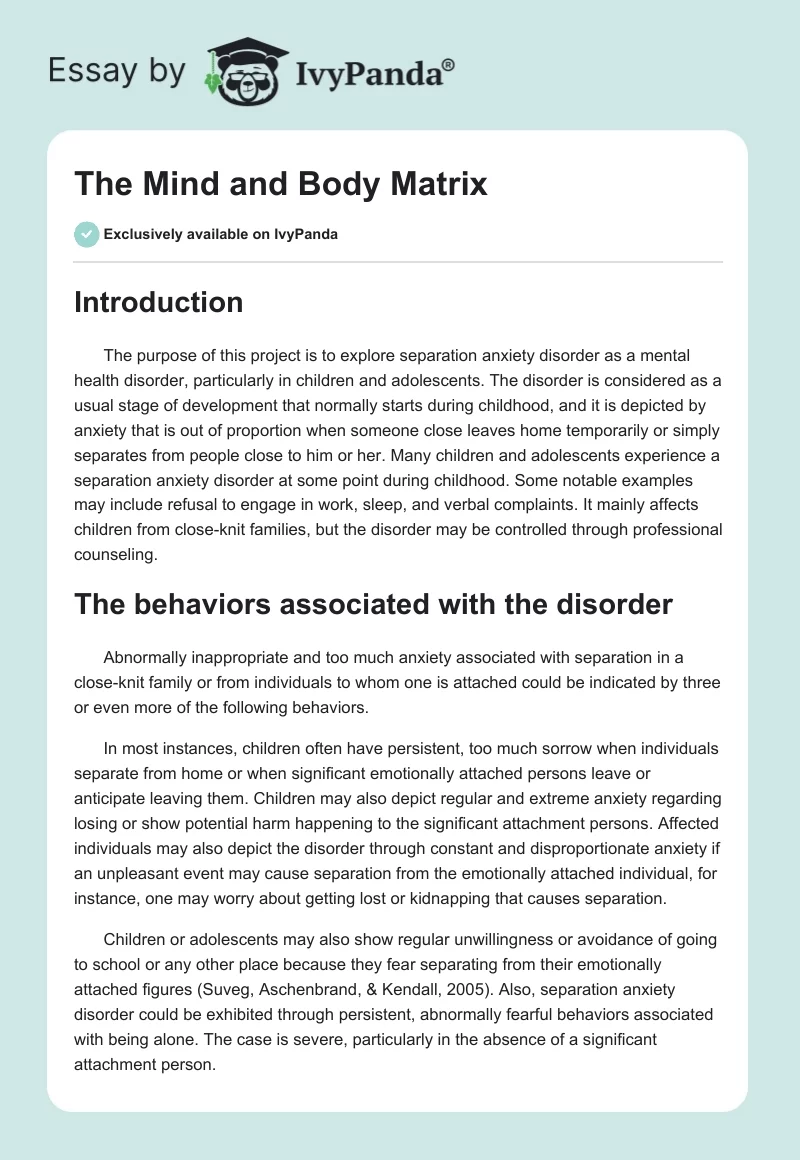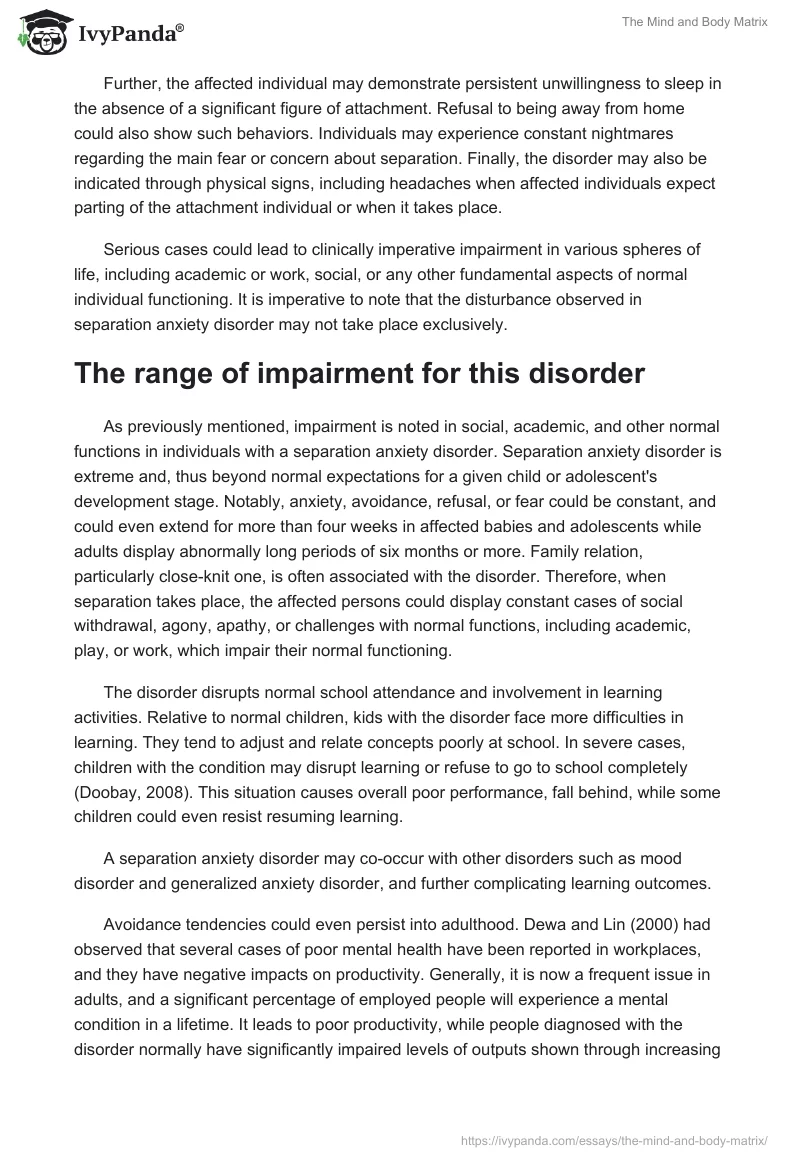Introduction
The purpose of this project is to explore separation anxiety disorder as a mental health disorder, particularly in children and adolescents. The disorder is considered as a usual stage of development that normally starts during childhood, and it is depicted by anxiety that is out of proportion when someone close leaves home temporarily or simply separates from people close to him or her. Many children and adolescents experience a separation anxiety disorder at some point during childhood. Some notable examples may include refusal to engage in work, sleep, and verbal complaints. It mainly affects children from close-knit families, but the disorder may be controlled through professional counseling.
The behaviors associated with the disorder
Abnormally inappropriate and too much anxiety associated with separation in a close-knit family or from individuals to whom one is attached could be indicated by three or even more of the following behaviors.
In most instances, children often have persistent, too much sorrow when individuals separate from home or when significant emotionally attached persons leave or anticipate leaving them. Children may also depict regular and extreme anxiety regarding losing or show potential harm happening to the significant attachment persons. Affected individuals may also depict the disorder through constant and disproportionate anxiety if an unpleasant event may cause separation from the emotionally attached individual, for instance, one may worry about getting lost or kidnapping that causes separation.
Children or adolescents may also show regular unwillingness or avoidance of going to school or any other place because they fear separating from their emotionally attached figures (Suveg, Aschenbrand, & Kendall, 2005). Also, separation anxiety disorder could be exhibited through persistent, abnormally fearful behaviors associated with being alone. The case is severe, particularly in the absence of a significant attachment person.
Further, the affected individual may demonstrate persistent unwillingness to sleep in the absence of a significant figure of attachment. Refusal to being away from home could also show such behaviors. Individuals may experience constant nightmares regarding the main fear or concern about separation. Finally, the disorder may also be indicated through physical signs, including headaches when affected individuals expect parting of the attachment individual or when it takes place.
Serious cases could lead to clinically imperative impairment in various spheres of life, including academic or work, social, or any other fundamental aspects of normal individual functioning. It is imperative to note that the disturbance observed in separation anxiety disorder may not take place exclusively.
The range of impairment for this disorder
As previously mentioned, impairment is noted in social, academic, and other normal functions in individuals with a separation anxiety disorder. Separation anxiety disorder is extreme and, thus beyond normal expectations for a given child or adolescent’s development stage. Notably, anxiety, avoidance, refusal, or fear could be constant, and could even extend for more than four weeks in affected babies and adolescents while adults display abnormally long periods of six months or more. Family relation, particularly close-knit one, is often associated with the disorder. Therefore, when separation takes place, the affected persons could display constant cases of social withdrawal, agony, apathy, or challenges with normal functions, including academic, play, or work, which impair their normal functioning.
The disorder disrupts normal school attendance and involvement in learning activities. Relative to normal children, kids with the disorder face more difficulties in learning. They tend to adjust and relate concepts poorly at school. In severe cases, children with the condition may disrupt learning or refuse to go to school completely (Doobay, 2008). This situation causes overall poor performance, fall behind, while some children could even resist resuming learning.
A separation anxiety disorder may co-occur with other disorders such as mood disorder and generalized anxiety disorder, and further complicating learning outcomes.
Avoidance tendencies could even persist into adulthood. Dewa and Lin (2000) had observed that several cases of poor mental health have been reported in workplaces, and they have negative impacts on productivity. Generally, it is now a frequent issue in adults, and a significant percentage of employed people will experience a mental condition in a lifetime. It leads to poor productivity, while people diagnosed with the disorder normally have significantly impaired levels of outputs shown through increasing rates of absenteeism, partial work periods, and procrastination of tasks (Dewa & Lin, 2000).
The implications of this disorder on society
While discomfort that arises from separation for children aged between eight and 14 months is considered normal, it has serious implications for children beyond this age group, adolescents and adults. Separation anxiety disorder occasionally causes nervousness among children when they encounter strange people or visit unfamiliar places. The behavior could persist beyond the age of six and last for several weeks.
Parents and care providers have additional responsibilities for children with a separation anxiety disorder. Consequently, they may respond poorly to any form of alleged anxiety in their care providers. The case could be complicated when adults who have a similar condition take care of the children because they may not be willing to confirm it. Therefore, families and care providers must recognize their conditions and feelings and evaluate them effectively for any eventual separation.
Society has often considered individuals with a separation anxiety disorder as demanding, pushy, and in search of regular attention. On this note, constant, extreme demands could be a cause of annoyance for care providers and families, which could cause anger and disagreement within the family. In some cases, kids with the conditions may be defined as oddly careful, compliant, and excited for recognition. Determining the condition itself could be a burden for the family.
Besides, prolonged mental conditions and related consequences associated with a separation anxiety disorder could be devastating to families. It is a critical factor for the vulnerability of affected individuals and is responsible for developing a psychiatric disorder in individuals aged between 19 and 30 years. The condition complicates mental issues when it co-occurs with other disorders.
Psychologists must always strive to diagnose the condition earlier to treat it. This is imperative to inhibit later complex stages in life. Besides, discussing the condition and possible separation could help in controlling unwanted outcomes.
Possible treatment options for the disorder
Separation anxiety disorder is treatable using one or more treatment options. Cognitive-behavioral therapy (CBT) has been identified as an effective means of assisting children with a separation anxiety disorder. The method involves exposure to possible separation situations to control thought processes associated with the condition. Psychologists have applied various phases of CBT, including patient education, application, and control of potential relapse.
Patients are educated on the extreme impacts of anxiety on both their physical and mental well-being. Psychologists ensure that patients understand and apply learned concepts to identify their situations and manage to control and successfully lessen overall negative reactions (Bogels & Zigterman, 2000). Cognitive treatment regimens are effective in much older children and adolescents who have the disorder. The overall goal of cognitive procedures is to help children to identify realistic risks associated with the identified cause of anxiety and then develop a strategy to cope with it. Thus, negative thought processes are destroyed in the process (Bogels & Zigterman, 2000).
Pharmacological interventions are also available to manage the disorder. The treatment is referred to as pharmacotherapy. This treatment option is applicable in cases of severe disorder, especially when other intervention options have been applied but produced poor outcomes (Waslick, 2005).
It is imperative to note that interventions with medications have yielded mixed outcomes and therefore could be difficult to justify in some cases. Also, no specific medication has been identified as more effective for the disorder relative to others (Suveg et al., 2005). Nevertheless, most medications demonstrate positive outcomes for patients.
Behavioral therapies are also effective means of treating separation anxiety disorder. Patients are exposed to possible separation situations gradually to control anxiety. Behavior is the most important factor for consideration with this treatment option.
Conclusion
The purpose of this project was to explore various aspects of separation anxiety disorder. It shows that the condition is common mainly in close-knit families among children but can also extend to adulthood. The disorder is associated with significant disruption in the lives of individuals. It affects social, education, and other aspects of normal functions. It can disturb normal schooling among children and affect working periods among adults.
Treatment options are available for the disorder. They include cognitive-behavioral therapies, pharmacotherapy, and behavioral therapies. These treatment options have provided positive outcomes based on the condition of the patient.
References
Bogels, S. M., & Zigterman, D. (2000). Dysfunctional cognitions in children with social phobia, separation anxiety disorder, and generalized anxiety disorder. Journal of Abnormal Child Psychology, 28(2), 205–211.
Dewa, C. S., & Lin, E. (2000). Chronic physical illness, psychiatric disorder and disability in the workplace. Social Science & Medicine, 51(1), 41–50. Web.
Doobay, A. F. (2008). School Refusal Behavior Associated with Separation Anxiety Disorder: A Cognitive-Behavioral Approach to Treatment. Psychology in the Schools, 45(4), 261–272. Web.
Suveg, C., Aschenbrand, S. G., & Kendall, P. C. (2005). Separation Anxiety Disorder, Panic Disorder, and School Refusal. Child and Adolescent Psychiatric Clinics of North America, 14(4), 773–795. Web.
Waslick, B. (2005). Psychopharmacology Interventions for Pediatric Anxiety Disorders: A Research Update. Child and Adolescent Psychiatric Clinics of North America, 15(1), 51–71. Web.


